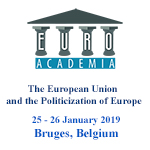Euroacademia Conferences
 Europe Inside-Out: Europe and Europeanness Exposed to Plural Observers (9th Edition) April 24 - 25, 2020
Europe Inside-Out: Europe and Europeanness Exposed to Plural Observers (9th Edition) April 24 - 25, 2020 Identities and Identifications: Politicized Uses of Collective Identities (9th Edition) June 12 - 13, 2020
Identities and Identifications: Politicized Uses of Collective Identities (9th Edition) June 12 - 13, 2020 8th Forum of Critical Studies: Asking Big Questions Again January 24 - 25, 2020
8th Forum of Critical Studies: Asking Big Questions Again January 24 - 25, 2020 Re-Inventing Eastern Europe (7th Edition) December 13 - 14, 2019
Re-Inventing Eastern Europe (7th Edition) December 13 - 14, 2019 The European Union and the Politicization of Europe (8th Edition) October 25 - 26, 2019
The European Union and the Politicization of Europe (8th Edition) October 25 - 26, 2019 Identities and Identifications: Politicized Uses of Collective Identities (8th Edition) June 28 - 29, 2019
Identities and Identifications: Politicized Uses of Collective Identities (8th Edition) June 28 - 29, 2019 The European Union and the Politicization of Europe (7th Edition) January 25 - 26, 2019
The European Union and the Politicization of Europe (7th Edition) January 25 - 26, 2019 7th Forum of Critical Studies: Asking Big Questions Again November 23 - 24, 2018
7th Forum of Critical Studies: Asking Big Questions Again November 23 - 24, 2018 Europe Inside-Out: Europe and Europeanness Exposed to Plural Observers (8th Edition) September 28 - 30, 2018
Europe Inside-Out: Europe and Europeanness Exposed to Plural Observers (8th Edition) September 28 - 30, 2018 Identities and Identifications: Politicized Uses of Collective Identities (7th Edition) June 14 - 15, 2018
Identities and Identifications: Politicized Uses of Collective Identities (7th Edition) June 14 - 15, 2018
The Role of Foreign Correspondents in Cultural and Science Diplomacy
-
-

-
Presentation speakers
- George Terzis, Department of Communication Studies, Vrije Universiteit Brussel, Belgium
- Linsey Armstrong, Syracuse University, New York, USA
Abstract:
This research attempts to examine the ‘diplomatic’ role foreign correspondents play in covering art and culture in general and cultural diplomacy initiatives in particular, as well as highlight trends, challenges and opportunities. Foreign correspondents play a vital role in delivering current news from countries abroad to audiences back home. Given their task of communicating news that is relevant to the country they are hosted in and to the audiences they are writing for, foreign correspondents often contribute to the perception of foreign countries to publics. Despite this, however, research about foreign correspondents’ “impact on diplomatic practice is virtually non-existent” (Archetti, 2011). With the European Union in general and different European countries in particular maintaining a strong focus on cultural diplomacy initiatives, it is imperative to explore how foreign correspondents covering art and culture as well as those initiatives affect the perception of the European Union and its member states to audiences abroad. The following research question then is explored: How do foreign correspondents shape the image of a foreign country or a multinational institution such as the EU to home audiences, particularly through coverage of art and culture and cultural diplomacy activities? By interviewing forty journalists based in London, Brussels, Paris and Berlin, this research sheds light on the work of foreign correspondents regarding art and culture writing, the level of access they have to sources abroad and current trends of foreign appetite for stories regarding art and culture. Given the recent trends of the impact of financial limitations, advances in communications technology and social media on foreign correspondents’ work, this research highlights a greater understanding of the challenges facing correspondents – particularly those covering art and culture.
-
Related Presentations

The Impact of the Eurozone Crisis and its Regulation on the Decrease of European Bank Mergers
- Evangelia Nissioti













